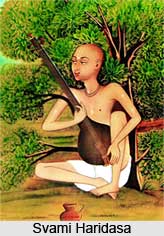 Svami Haridasa was a great musician and also a devotee of Lord Krishna. He lived a saintly life in Vrindavan. He used the charisma of his music to awaken Bhakti (devotion) for Bhagavan Krishna in the hearts of millions of Hindus. He sang of the glory of Lord Krishna through his Dhrupads. In these he portrayed himself as a Sakhi (female companion) of Krishna and emphasized this relationship of Sakhi-Bhava (i.e. relationship if intense love and devotion of a Sakhi for her beloved Krishna in his worship as well as in his Dhrupads. Based on his emphasis of this Sakhi-Bhava in his worship of Krishna he founded a religious sect in Vrindavan which is called Sakhi-Sampradaya or Haridasi-Sampradaya. Many Hindus look upon Svami Haridasa as an avatara (incarnation) of Lalita, the favourite Sakhi of Krishna.
Svami Haridasa was a great musician and also a devotee of Lord Krishna. He lived a saintly life in Vrindavan. He used the charisma of his music to awaken Bhakti (devotion) for Bhagavan Krishna in the hearts of millions of Hindus. He sang of the glory of Lord Krishna through his Dhrupads. In these he portrayed himself as a Sakhi (female companion) of Krishna and emphasized this relationship of Sakhi-Bhava (i.e. relationship if intense love and devotion of a Sakhi for her beloved Krishna in his worship as well as in his Dhrupads. Based on his emphasis of this Sakhi-Bhava in his worship of Krishna he founded a religious sect in Vrindavan which is called Sakhi-Sampradaya or Haridasi-Sampradaya. Many Hindus look upon Svami Haridasa as an avatara (incarnation) of Lalita, the favourite Sakhi of Krishna.
Whatever information is obtained about the life and the music of Svami Haridasa comes down from the 16th and 17th century writers of the Bhakti cult of Vallabhacharya. Svami Haridasa lived a saintly life far removed from the courts of any of the kings and the rulers of the time. According to one account Svami Haridasa was born in A.D. 1490 near Vrindavan, but others hold that Svamiji was born in A.D. 1480 in Aligarh in a Brahmin family. Svami Haridasa had a religious bent from his childhood and at the age of twenty-five he left his house and went to Vrindavan to lead a sacred life. He opened an Asrama (hermitage) there and lived an austere life dedicated to the worship of Bhagavan Krishna. Again, there is no definite view as to who the Guru of Svamiji was. While some say that Baiju was the guru of Svami Haridasa, according to another it is just the other way round i.e. Svami Haridasa was the guru of Baiju.
The Dhrupads composed by Svami Haridasa were primarily of a devotional nature and thus belong to the category of Haveli (temple) Dhrupads as opposed to Darabari Dhrupads. Since the Dhrupads of Svami Haridasa were composed and sung by him in the worship of Bhagavan Krishna who, according to Hindu belief, is an Avatara (incarnation) of Lord Vishnu, these Dhrupads are called Vishnupadas. There are two collections of Svami Haridasa`s Dhrupads. These are `Siddhanta` and `Kelimala`. Siddhanta is a collection of eighteen Dhrupads and Kelimala is a collection of hundred and ten Dhrupads. In all, there are thus hundred and twenty-eight Dhrupads of Svami Haridasa that are available. Of these thirty are in Raaga Kanhada which it seems was Svamiji`s favourite Raaga. He also wrote and sang Dhrupads in Raaga Kalyana which is very similar to Raaga Yamana and has much the same notes.
Svami Haridasa died about A.D. 1575. The place of honour he holds in the hearts of the Indians is reflected in the fact that every year his birth anniversary is celebrated in Vrindavan the form of Haridasa Jayanti.




















